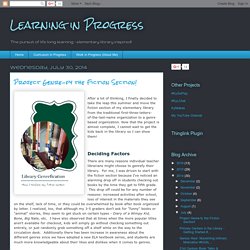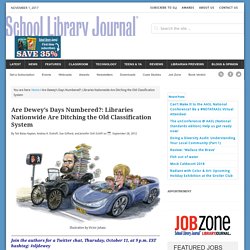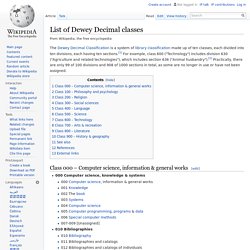

Learning in Progress: Project Genre-fy the Fiction Section! After a lot of thinking, I finally decided to take the leap this summer and move the fiction section of my elementary library from the traditional first-three-letters-of-the-last-name organization to a genre based organization.

Now that the project is almost complete, I cannot wait to get the kids back in the library so I can show them! Deciding Factors There are many reasons individual teacher librarians might choose to genrefy their library. For me, I was driven to start with the fiction section because I've noticed an alarming drop off in students checking out books by the time they get to fifth grade. This drop off could be for any number of reasons: increased activities after school, loss of interest in the materials they see on the shelf, lack of time, or they could be overwhelmed by book after book organized by letter. The Big Weeding I admit, my process was a bit scattered as a jumped into this.
Of the entire process, pulling the "Award Winners" took the longest. 1. 2. 3. Complete BISAC Subject Headings, 2014 Edition. Begin the simple, two-step process for choosing your BISAC Subject Heading below.

Note: If you need to download and incorporate this list into your databases and systems, click here to obtain an End Users' License Agreement. If you can't find the code you're looking for please go back and review other Major Subjects to find an alternate code or use our Contact Form to suggest revisions to the next version of the list. Step 1: Determine the major heading which best describes the content of your book.
Click on a heading below for more specific headings within that category. If your title does not have subject content, i.e. a blank book, please use the Non-Classifiable term below. Are Dewey’s Days Numbered?: Libraries Nationwide Are Ditching the Old Classification System. By Tali Balas Kaplan, Andrea K.

Dolloff, Sue Giffard, and Jennifer Still-Schiff on September 28, 2012 Illustration by Victor Juhasz Join the authors for a Twitter chat, Thursday, October 11, at 9 p.m. EST hashtag: #sljdewey. Whole Number Dewey: A Year Without Decimals. Posted by Mrs.

J in the Library in Books, How to Be Brave, Reflections. Tags: catalog, cataloging, collection development, Dewey decimal system, library management, MARC records trackback It’s been almost a whole school year since I hit the “Import Titles” button and replaced ALL of my Dewey number MARC records with call numbers sans decimals. It was a bit daunting making such a wildly revolutionary decision. Thanks to some VERY dedicated volunteers, countless hours spent re-stickering spine labels, and new, large, and colorful signs, however, I honestly think that the change has made our nonfiction section more accessible to students and faculty. Here are some of my discoveries and reflections… It took almost a full school year to re-sticker everything…with a part-time assistant and a few fantastic volunteers spending every non-shelving moment on this project (without working in the summer).
Knowing your collection and your students is crucial. Like this: Like Loading... Related. The Dewey Dilemma. By Barbara Fister In the search for better browsability, librarians are putting Dewey in a different class By Barbara Fister — Library Journal, 10/01/2009 Not long ago, a mother blogged about her visit to a newly opened public library in Darien, CT.

Though she appreciated its soaring ceilings, the fireplaces and cozy nooks, the presence of a café, and state-of-the-art technology, what really excited her was the way the books were organized. We Spiced Up The Shelves....And Ditched The Dewey. Something really big has been happening in the Van Meter School Elementary Library over the last few months.

We are always doing things within our library, school, and community to get our young people reading, learning, thinking, collaborating, and creating. One of the ways that we can encourage all of these things within the library is to take a look around and see what changes we can make. I looked at the way our collection was organized, where and how our students browsed in the library, what books they looked at and checked out, and the books and sections they were not looking at all.
Last year when we put all of our Graphic Novels together, this quickly became the most popular place to go in the library. And it also made me realize how many more Graphic Novels we needed in our collection to support our readers. FAME14: Ditching Dewey. Ditching Dewey! List of Dewey Decimal classes. The Dewey Decimal Classification is a system of library classification made up of ten classes, each divided into ten divisions, each having ten sections.[1] For example, class 600 ("Technology") includes division 630 ("Agriculture and related technologies"), which includes section 636 ("Animal husbandry").[1] Practically, there are only 99 of 100 divisions and 908 of 1000 sections in total, as some are no longer in use or have not been assigned.

Class 000 – Computer science, information & general works[edit] Class 100 – Philosophy and psychology[edit] Class 200 – Religion[edit] Class 300 – Social sciences[edit] Class 400 – Language[edit] Class 500 – Science[edit] Class 600 – Technology[edit]